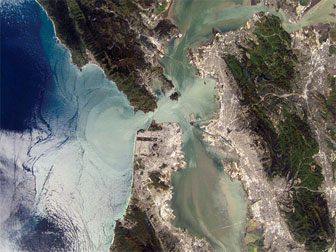EPA sued for San Francisco Bay Area pesticide use
EPA sued for San Francisco Bay Area pesticide use
mongabay.com
May 30, 2007
The Center for Biological Diversity, an environmental group, sued the U.S. Environmental Protection Agency on Wednesday, accusing the agency of approving the use of 46 pesticides without determining whether the chemicals threaten 11 endangered species in the San Francisco Bay Area.
The environmentalists chose the 100th birthday of Rachel Carson, whose 1962 book Silent Spring raised awareness about the impact of pesticides on the environment and human health, to file the suit.
“Ending the use of known poisons in habitat for our most endangered wildlife is an appropriate 100th birthday tribute to Rachel Carson, who alerted us to the hazards of exposure to toxic chemicals almost half a century ago,” said Jeff Miller, of the Center for Biological Diversity. “Unfortunately the EPA has not learned from her legacy and still has no plan to adequately assess impacts while registering and approving pesticide uses that pose a clear and present danger both to imperiled species and human health .”
 This view featuring the San Francisco Bay Area was photographed by an Expedition 4 crew member onboard the International Space Station. Image credit: NASA |
The Center for Biological Diversity said that at least 61 million pounds of pesticide active ingredients were applied in Bay Area counties from 1999 through 2005. It alleges “the EPA has consistently failed to consult with the U.S. Fish and Wildlife Service on endangered species impacts when registering and authorizing use of toxic pesticides” as required by law.
The Center for Biological Diversity reports that studies by the Fish and Wildlife Service, EPA, U.S. Geological Survey and California Department of Pesticide Regulation “show that at least 46 pesticides of concern are used or accumulate in or adjacent to (upstream or upwind) habitat for 11 Bay Area endangered species: Bay and Delta aquatic habitat for the critically endangered delta smelt (Hypomesus transpacificus) and the tidewater goby (Eucyclogobius newberryi); tidal marshland habitat for the California clapper rail (Rallus longirostris obsoletus) and salt marsh harvest mouse (Reithrodontomys raviventris); freshwater and wetlands habitat for the California tiger salamander (Ambystoma californiense), San Francisco garter snake (Thamnophis sirtalis tetrataenia) and California freshwater shrimp (Syncaris pacifica); and terrestrial habitat for the San Joaquin kit fox (Vulpes macrotis mutica), Alameda whipsnake (Masticophis lateralis euryxanthus), valley elderberry longhorn beetle (Desmocerus californicus dimorphus) and bay checkerspot butterfly (Euphydryas editha bayensis).”
“The registrations of contaminants known to be deadly to endangered species and harmful to human health, such as atrazine, should be cancelled,” said Miller. “Given the proximity of agricultural pesticide spraying to some Bay Area residential areas, surveys that have detected accumulation of pesticides in local creeks and San Francisco Bay, and what we know about movement of pesticides through drift and runoff, we should be wondering if we are next when we see endangered species poisoned by these chemicals.”
This article is based on a news release from the Center for Biological Diversity














